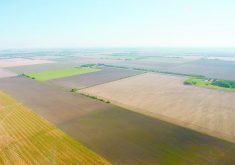A program in four Alberta hospitals focuses on mobility among the elderly to maintain muscle strength and reduce depression
Increasing mobility can decrease the length of time a senior stays in hospital, says a geriatrics specialist.
“Statistics say that one-third of the elderly will decline in hospital in function and half will not regain that function,” Jayna Holroyd-Leduc, a professor in the University of Calgary’s department of medicine, told the 8th Annual Summit of the Knowledge Network in Rural and Remote Dementia Care in Saskatoon Oct. 28.
Seniors lose one to five percent of muscle strength each day without mobilization, she added.
Alberta’s Mobilization of Vulnerable Elderly (MOVE) initiative, which is being implemented in Olds, Sturgeon, Medicine Hat and Lethbridge, is designed to get seniors out of bed and walking or sitting each day.
Read Also

Livestock leads Canada’s farm economic outlook
Forecasts by a major Canadian farm lender featured good and bad news on the financial health of both farmers and Canadians at large.
“We may deal with an acute medical issue, but if we don’t deal with other things while they’re there, overall they may not improve,” Holroyd-Leduc said.
“Ideally, we want to make people better, not worse.”
She said the task is shared by all health-care workers from doctors to assistants.
The idea comes from a similar program, Move Ontario, which found that one in 20 elderly patients who received this activity three times a day maintained their pre-injury mobility level.
Holroyd-Leduc said training is provided for health-care workers so that they focus more on mobility for seniors every day.
“You are doing something different with what you already have.”
MOVE is one of the “elder friendly” initiatives that are being introduced in Alberta, where seniors often show up with a need for acute care but also have cognitive and functional issues.
Holroyd-Leduc said they hope to decrease the rates of depression commonly seen in patients with dementia and Parkinson’s.
Other elder friendly care goals include managing pain and basic needs, creating safe spaces, limiting the use of restraints and regularly orienting them to where they are.
“We want to minimize them from hurting themselves,” she said.
Results of the program will be assessed to determine how it can be improved.
A study now underway by graduate student Zahra Goodarz will look at screening tools, barriers to detecting problems and best management practices.
Elderly patients often can’t be diagnosed because of cognitive challenges so doctors must rely on caregivers and family to help them.
“If we do diagnose them, the underlying disease is better, especially among Parkinson’s sufferers.”
That’s especially important in rural and remote areas that have fewer specialists such as geriatricians and neurologists.
“A generalist knows a lot of things but may not know them in great depth,” Holroyd-Leduc said.
She said videoconferences could help keep seniors from always having to leave their home communities to see doctors.
“I think it’s really sad when a person’s day revolves around seeing care providers.”















